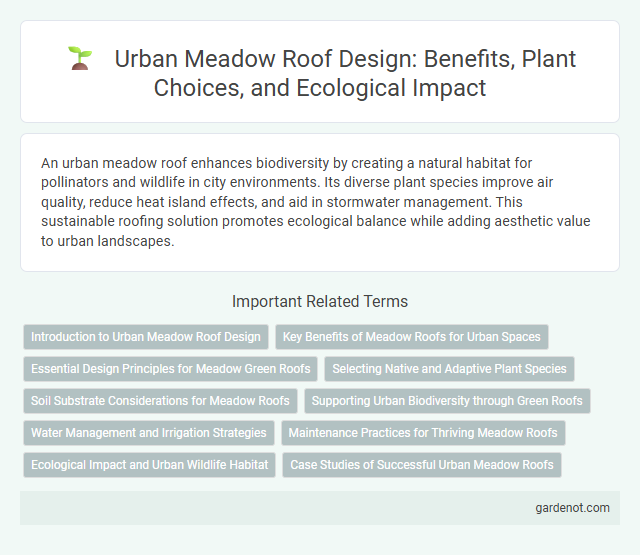An urban meadow roof enhances biodiversity by creating a natural habitat for pollinators and wildlife in city environments. Its diverse plant species improve air quality, reduce heat island effects, and aid in stormwater management. This sustainable roofing solution promotes ecological balance while adding aesthetic value to urban landscapes.
Introduction to Urban Meadow Roof Design
Urban meadow roof design integrates diverse native grasses, wildflowers, and plants to create sustainable green spaces that enhance urban biodiversity and manage stormwater effectively. This approach prioritizes low-maintenance vegetation adapted to local climates, promoting ecological balance while improving air quality and reducing the urban heat island effect. Incorporating urban meadow roofs can significantly contribute to energy efficiency and provide habitats for pollinators in dense city environments.
Key Benefits of Meadow Roofs for Urban Spaces
Urban meadow roofs enhance biodiversity by providing vital habitats for pollinators and bird species within city environments. They improve air quality and reduce urban heat island effects by increasing vegetation cover and evapotranspiration. These green roofs also contribute to stormwater management by absorbing and filtering rainwater, reducing runoff and pressure on urban drainage systems.
Essential Design Principles for Meadow Green Roofs
Urban meadow roofs require essential design principles such as proper substrate depth of at least 15-20 cm to support diverse native grasses and wildflowers. Drainage layers and waterproof membranes ensure structural integrity and prevent waterlogging in green roof systems. Incorporating native plant species tailored to the local climate promotes biodiversity and enhances stormwater management in urban environments.
Selecting Native and Adaptive Plant Species
Urban meadow roofs thrive by selecting native and adaptive plant species that enhance biodiversity and require minimal maintenance. Choosing drought-tolerant, deep-rooted perennials such as native grasses and wildflowers ensures resilience in varying urban microclimates. Incorporating species like purple coneflower (Echinacea purpurea) and little bluestem (Schizachyrium scoparium) promotes ecological balance and supports local pollinators.
Soil Substrate Considerations for Meadow Roofs
Urban meadow roofs require carefully selected soil substrates with high porosity and adequate nutrient content to support diverse native plant species and ensure proper water drainage. Lightweight, well-draining substrates composed of organic matter, sand, and mineral components optimize root growth and reduce structural load on buildings. Maintaining a balanced pH (around 6.0-7.0) and appropriate moisture retention is essential for sustaining meadow biodiversity and long-term roof performance.
Supporting Urban Biodiversity through Green Roofs
Urban meadow roofs enhance urban biodiversity by providing vital habitats for pollinators such as bees, butterflies, and native bird species. These green roofs support diverse plant communities that mimic natural meadows, improving ecological connectivity in city landscapes. Incorporating native grasses and wildflowers on urban meadow roofs promotes resilience against climate extremes while bolstering local wildlife populations.
Water Management and Irrigation Strategies
Urban meadow roofs enhance water management by efficiently capturing and retaining rainwater, reducing runoff and promoting groundwater recharge. Strategic irrigation techniques, such as drip irrigation and rainwater harvesting systems, optimize water use while supporting diverse native plant species adapted to local climates. These sustainable methods minimize water consumption and maintain the ecological balance within urban environments.
Maintenance Practices for Thriving Meadow Roofs
Urban meadow roofs require regular maintenance such as seasonal weeding, watering during dry spells, and periodic mowing to promote plant diversity and prevent invasive species dominance. Monitoring soil health and ensuring adequate drainage are critical for sustaining native grasses and wildflowers in these rooftop ecosystems. Implementing a tailored maintenance schedule based on local climate conditions enhances biodiversity and maximizes the ecological benefits of green roofs.
Ecological Impact and Urban Wildlife Habitat
Urban meadow roofs significantly enhance ecological impact by promoting biodiversity and supporting pollinator populations in metropolitan environments. They create essential urban wildlife habitats that offer food, shelter, and breeding grounds for insects, birds, and small mammals, contributing to the restoration of native ecosystems. The increased green cover also aids in air purification, temperature regulation, and stormwater management, making urban meadows crucial for sustainable city living.
Case Studies of Successful Urban Meadow Roofs
Urban meadow roofs, as demonstrated by the California Academy of Sciences in San Francisco, showcase biodiversity enhancement by supporting over 1,700 native plant species and attracting diverse pollinators. The L'Oreal Group's Paris headquarters urban meadow roof reduces urban heat island effect and manages stormwater efficiently through its native grasses and wildflowers. These case studies underline the ecological and environmental benefits of integrating urban meadow roofs in city environments for sustainable urban development.
Urban meadow roof Infographic

 gardenot.com
gardenot.com